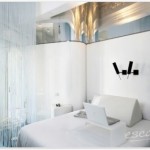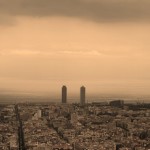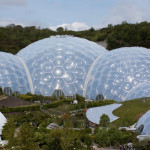I didn’t know much about him before visiting Barcelona, other than his name and architecture is synonymous with the Catalan city.
However, my visit to Barcelona and my brief exposure to the memorable work of Antoni Gaudí left me wanting to know more.
Gothic Architecture & Sagrada Familia
Senyor Gaudí aside, Barcelona’s old town is dominated by eye-catching gothic architecture and so you already feel artistically spoilt by the time you arrive in front of one of Gaudí’s, Barcelona’s and possibly Spain’s most recognisable landmarks, Sagrada Familia.
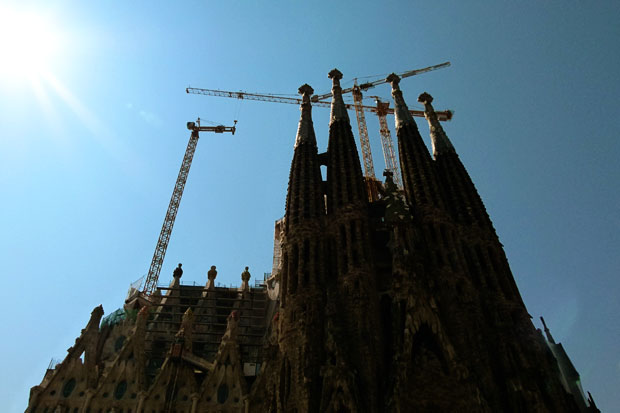
Sagrada Familia
At first glance the overall silhouette of Sagrada Familila is fairy tale like, as though it was envisaged in a dream or in a drug-fuelled high. However, look closer and there’s much more to it, it not least the dominant religious theme (Sagrada Familia means Holy Family) and it’s often overlooked by those who just swing by for a look at the fascinating exterior that this is a church, a place of worship.
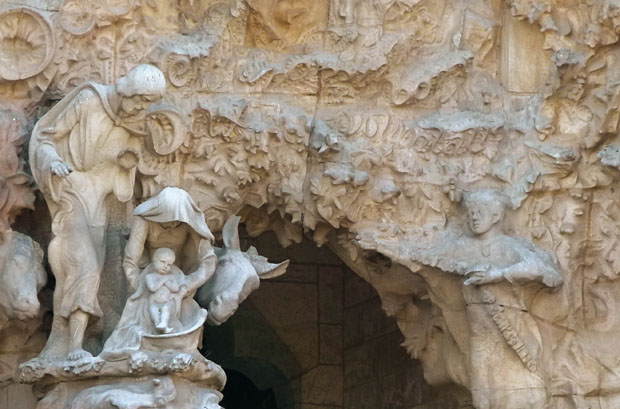
Religious theme of Sagrada Familia
My retrospective research informed me that Gaudí was strongly and soberly influenced by his Catholic faith, which deepened during his life and his five point cross is instantly recognisable by anyone with the most basic knowledge of Gaudí. I spent longer than most standing opposite the front of Sagrada Familia using my camera to zoom in, trying to make sense of the characters, vaguely relating them to Biblical events I recalled, all the while finding myself completely mesmerised by the vision Gaudí must of had when he took over and transformed the building’s construction a year after it started in 1882.
Sagrada Familia is now famously known as Spain’s longest work in progress and this vision is now managed by those responsible for continuing its work, which has an estimated completion date of 2028, more than 100 years after Gaudí died. There are unashamed differences in colour and texture of the brick where old meets new, although it looks a little stilted at first, it becomes part of the character.
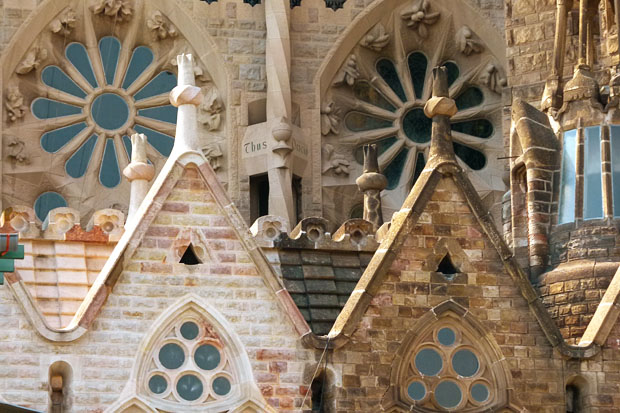
Sagrada Familia old meets new brick
Parc Güell
Character also oozes out of the mosaics of Parc Güell, arguably Gaudí’s second best known work in Barcelona. Found seemingly in the middle of nowhere along a picturesque residential street in north-east Barcelona, Parc Güell was over run with tourists wanting to enjoy the park’s views of the city and spot the famous mosaic salamander which is also symbolic of Gaudí’s broken mosaic style of art.
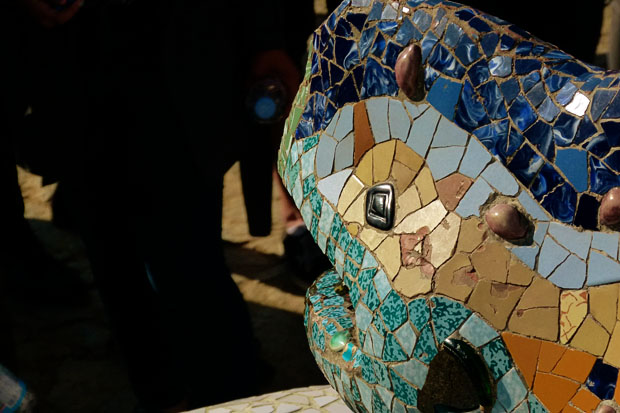
Mosaics of Parc Güell
As bus loads of tourists flocked around me I persevered in letting my first impressions be uninterrupted before taking more time trying to understand what Gaudí wanted to achieve when he envisaged Parc Güell. It feels like one of his most modernistic works, the colour and curves betray traditional gothic architecture, and with the intriguing leaning pillars of the walkways below the jutting out curved seating areas, reportedly designed for optimum comfort, I couldn’t help but feel sure that Gaudí wanted this space to be explored, enjoyed and shared.
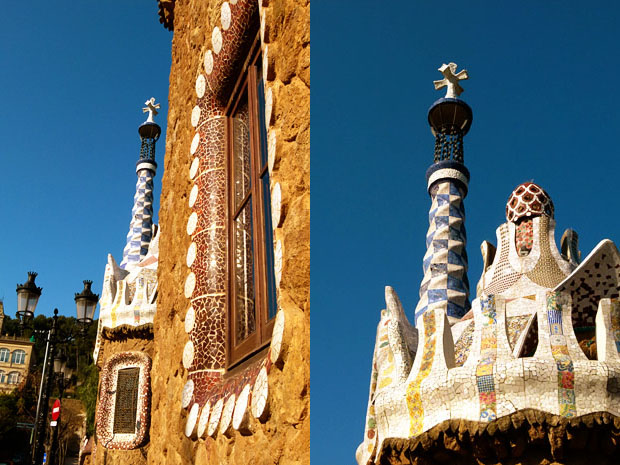
Parc Güell
Gaudí’s Barcelona
At this point I started to wonder if Gaudí was not only a highly skilled and creative architect but was also capable of predicting the future. Did he know and was motivated by the draw that his work would have on people in the future? Probably not. Gaudí’s Barcelona was a very different city to the one millions of tourists now flock to each year. It was an industrial hub and one of the biggest ports on the Mediterranean, which only really developed it’s pull as a tourist attraction as a result of vast urban development which occurred in the run up to the 1992 Olympics. Gaudí arrived in the city in 1868 aged 16 as a student and fell into architecture almost by accident as he also studied numerous other subjects though didn’t excel in all. There are also reports that he was not the most dynamic of individuals, with a reputation for being anti-social and even unpleasant, due perhaps in part to having suffered form ill-health on and off throughout his life. Gaudí also never married, devoting his life to his work; his last home before his death was his workshop at Sagrada Familia.
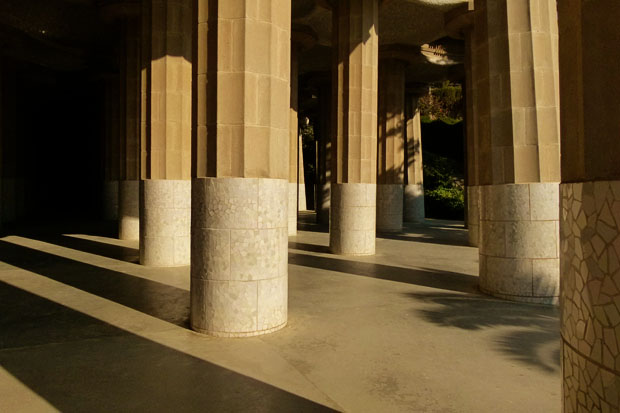
Gaudí's Barcelona was a very different city
And yet back in Parc Güell, although I am looking at mosaics made up of purposefully broken up tiles and patterns, which carries a slightly sinister undertone, I also note that they are put back together again and that they are colourful, beautiful and certainly very intriguing.
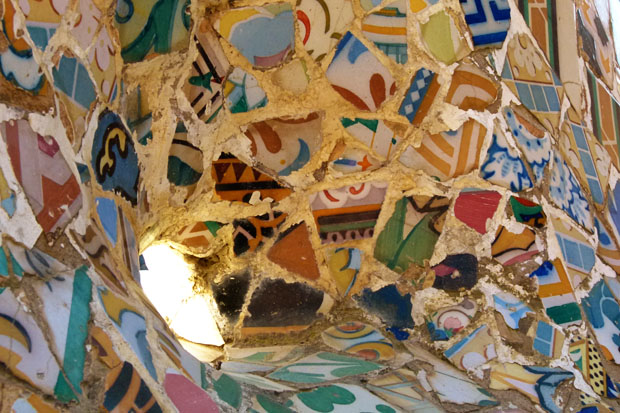
Gaudi's mosaics
They are not to be ignored or overlooked, I feel certain that Gaudí wanted them to be observed and enjoyed, at great length. Inspired by his architecture I would daydreamily like to think that Gaudí worked so hard and tirelessly towards this because this prospect pleased him and how happy he would be to know how many millions continue to enjoy it now.
Have you been to visit Gaudi’s architecture in Barcelona? What did you think? Were you impressed?

